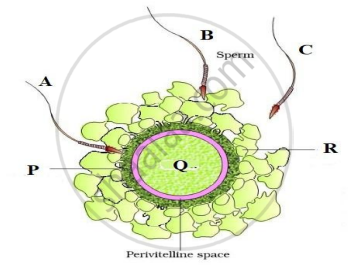Advertisements
Advertisements
प्रश्न
Match the following and choose the correct options:
| A. | Trophoblast | i. | Embedding of blastocyst in the endome |
| B. | Cleavage | ii. | Group of cells that would differentiate as embryo |
| C. | Inner cell mass | iii. | Outer layer of blastocyst attached to the endometrium |
| D. | Implantation | iv. | Mitonic division of zygote |
विकल्प
A-iii, B-iv, C-ii, D-i
A-iii, B-i, C-ii, D-iv
A-ii, B-iv, C-iii, D-i
A-ii, B-i, C-iii, D-iv
उत्तर
A-iii, B-iv, C-ii, D-i
APPEARS IN
संबंधित प्रश्न
Briefly explain the events of fertilisation and implantation in an adult human female.
Fill in the blanks:
Zygote is __________. (diploid/haploid)
State three functions of the placenta
If mammalian ovum fails to get fertilized, which one of the following is unlikely?
Cleavage starts after fertilization in ______.
Which part of the sperm plays an important role in penetrating the egg membrane?
The solid mass of 8-16 cells formed from zygote after successive mitotic divisions is called ______.
Which of the following hormones prepares the uterus for implantation?
Read the following and answer from given below:
Cleavage is the series of rapid mitotic divisions in the zygote and forms blastula. The 2, 4, 8, 16 daughter cells are called blastomeres. An embryo with 64 blastomeres is known as a blastocyst and has a blastocoel cavity. Blastocyst gets implanted in the uterine wall and leads to pregnancy.
The Site of implantation is ______
The figure given below shows 3 sperms A, B and C.
- Which one of the three sperms will gain entry into the ovum?
- Describe the associated changes induced by it on P and Q.

Ovum surrounded by few sperms
